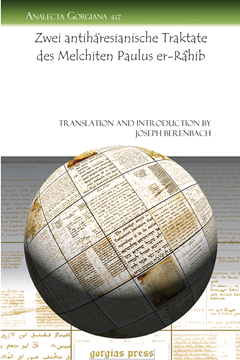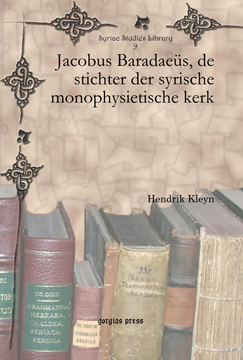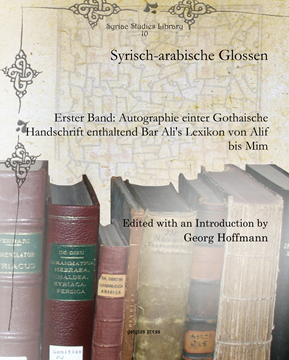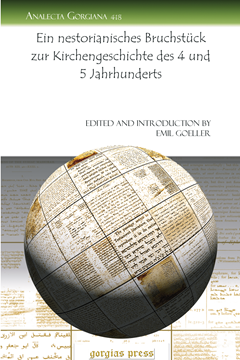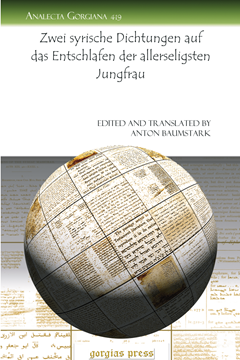Zwei antihäresianische Traktate des Melchiten Paulus er-Râhib
Translation and Introduction by Joseph Berenbach
Series: Analecta Gorgiana 417
ISBN: 978-1-60724-694-7
Joseph Berenbach presents here the Arabic text and German translation of an important anti-heretical work by the Melkite Christian author Paul er-Rahib. Berenbach describes the manuscripts used in the critical text and introduces the character of Paul.
$38.00 (USD)
The Rabbis’ King-Parables
Midrash From the Third-Century Roman Empire
Series: Judaism in Context 7
ISBN: 978-1-61719-159-6
The Rabbis’ King-Parables: Midrash From the Third-Century Roman Empire examines the ancient Rabbis at work using parables about kings; parables that reflect the Rabbis' ideas about the role of the ruler in society, and the relationship of humanity to God. It considers the parables as resistance literature in light of the work of theorists of dominated groups. It is the first systematic attempt to read the parables as sources for Roman history in over 100 years.
$199.00 (USD)
Chronicle of the Unknown Edessan
Translated into Arabic by Albert Abouna
Series: Abrohom Nuro Library 5
ISBN: 978-1-60724-695-4
The Syriac Chronicle of the Unknown Edessan (Chronicle of 1234) is an important resource for the period stretching from early Islam until the Crusades. The original manuscript, dating from the fourteenth century, was discovered by Patriarch Afram II Rahmani in Istanbul in 1899. The Syriac text was published by Chabot in collaboration with Afram Barsoum (later Patriarch Afram I Barsoum). The chronicle consists of two parts: Part I covers early world history, while Part II covers early Islam and is an eyewitness account of the Crusades. In this edition, Albert Abouna provides an Arabic translation of Part II with annotations. The volume includes comprehensive indices of names and places.
$189.00 (USD)
The Syriac Lexicon Hasan Bar Bahlul (1 of 3 volumes)
Edited with an Introduction by Rubens Duval
Series: Syriac Studies Library 2
ISBN: 978-1-60724-780-7
The encyclopedic lexicon of Bar Bahlul (10th century) explains Syriac words, as well as Greek words met in Syriac literature, in Syriac and Arabic. Vol. 3 includes an introduction and indices for the individual languages and biblical passages cited.
$213.00 (USD)
The Syriac Lexicon Hasan Bar Bahlul (2 of 3 volumes)
Edited with an Introduction by Rubens Duval
Series: Syriac Studies Library 2
ISBN: 978-1-60724-781-4
The encyclopedic lexicon of Bar Bahlul (10th century) explains Syriac words, as well as Greek words met in Syriac literature, in Syriac and Arabic. Vol. 3 includes an introduction and indices for the individual languages and biblical passages cited.
$222.00 (USD)
The Syriac Lexicon Hasan Bar Bahlul (3 of 3 volumes)
Edited with an Introduction by Rubens Duval
Series: Syriac Studies Library 2
ISBN: 978-1-60724-782-1
The encyclopedic lexicon of Bar Bahlul (10th century) explains Syriac words, as well as Greek words met in Syriac literature, in Syriac and Arabic. Vol. 3 includes an introduction and indices for the individual languages and biblical passages cited.
$213.00 (USD)
Jacobus Baradaeüs, de stichter der syrische monophysietische kerk
Series: Syriac Studies Library 9
ISBN: 978-1-60724-783-8
In this study, H. G. Kleyn deals with the life and works of Jacob Baradaeus and the role he played in the “monophysite” church to the time of his death in 578, including a thorough outline of Jacob’s writings.
$168.00 (USD)
Syrisch-arabische Glossen
Erster Band: Autographie einter Gothaische Handschrift enthaltend Bar Ali's Lexikon von Alif bis Mim
Edited with an Introduction by Georg Hoffmann
Series: Syriac Studies Library 10
ISBN: 978-1-60724-784-5
The ninth-century Syriac-Arabic lexicon of Bar Ali stands with Bar Bahlul’s as a main witness to contemporary Syriac lexicography. Hoffmann presents the first half of the work—the second was edited by Gottheil—with a critical apparatus.
$181.00 (USD)
Ein nestorianisches Bruchstück zur Kirchengeschichte des 4 und 5 Jahrhunderts
Edited with an Introduction by Emil Goeller
Series: Analecta Gorgiana 418
ISBN: 978-1-60724-709-8
Emil Goeller introduces and provides the text of a unique resource for the ecclesiastical history of the “Nestorian” church. The text, presented in Syriac with a Latin translation, is a compilation of historical sources focused on the story of Nestorius.
$36.00 (USD)
Zwei syrische Dichtungen auf das Entschlafen der allerseligsten Jungfrau
Edited and Translated by Anton Baumstark
Series: Analecta Gorgiana 419
ISBN: 978-1-60724-710-4
Anton Baumstark publishes two memre on the subject of Mary’s passing. The first is attributed to Jacob of Serug and the second to John of Birta. Baumstark also provides a brief introduction to the texts.
$40.00 (USD)
